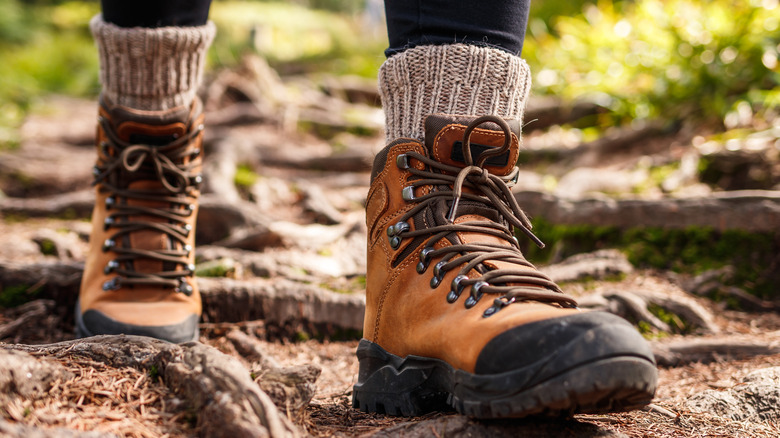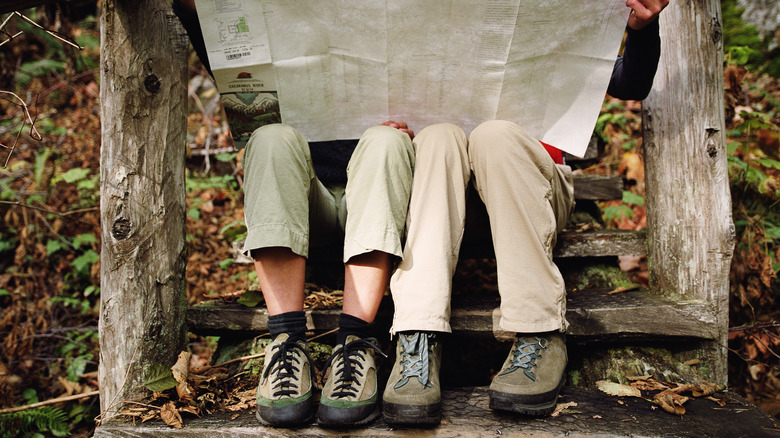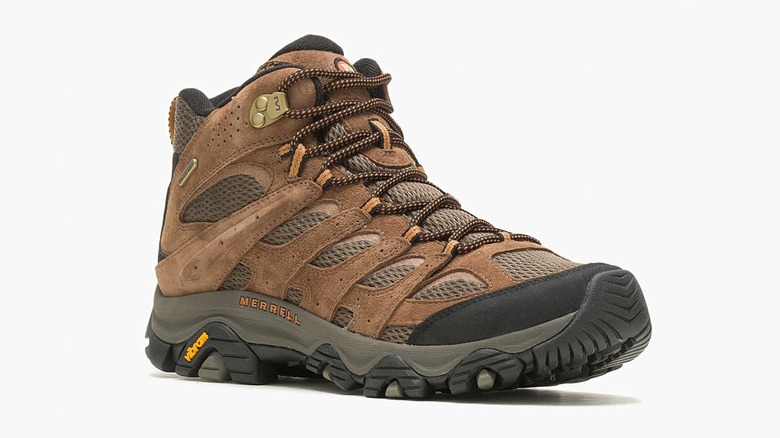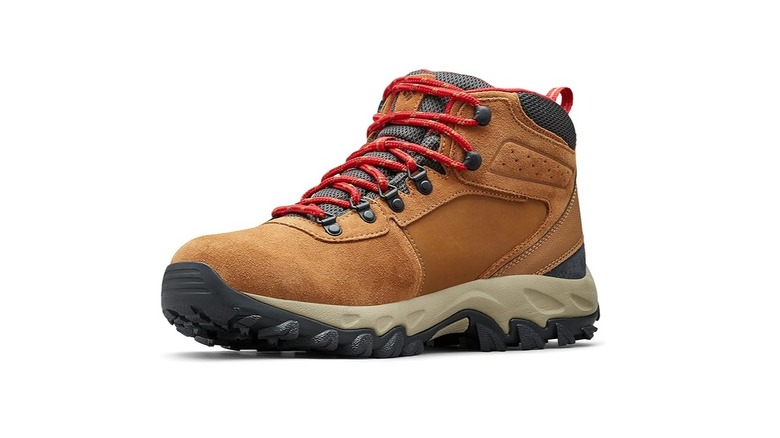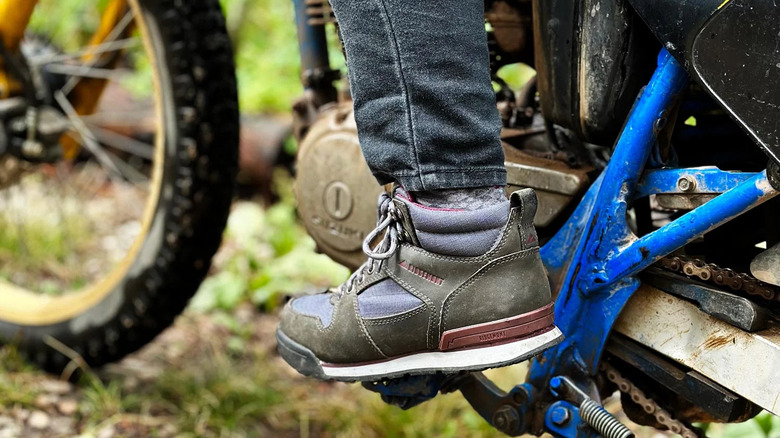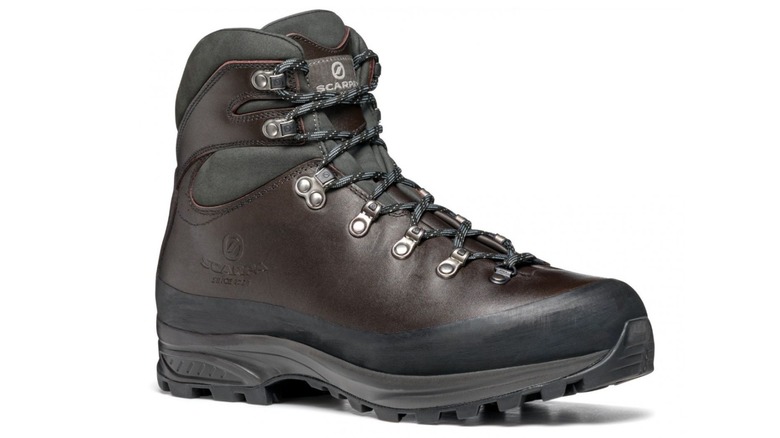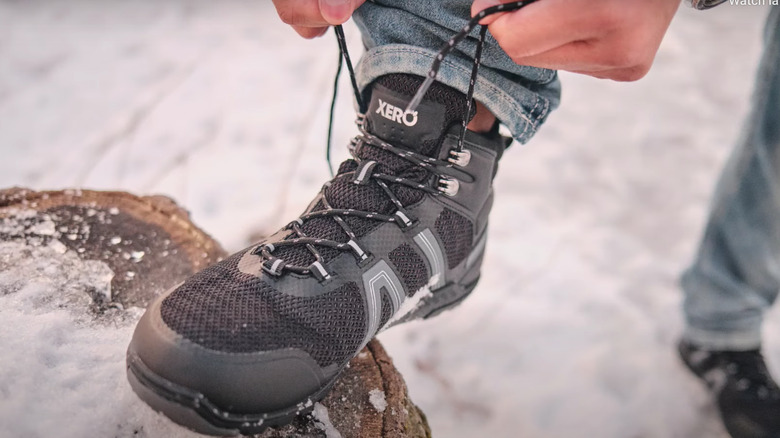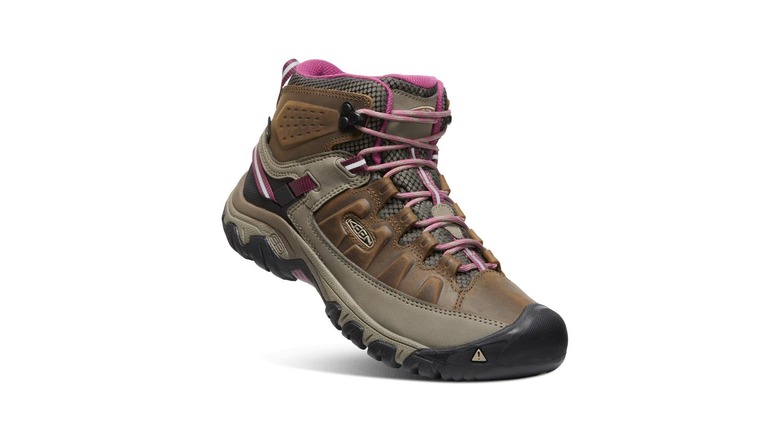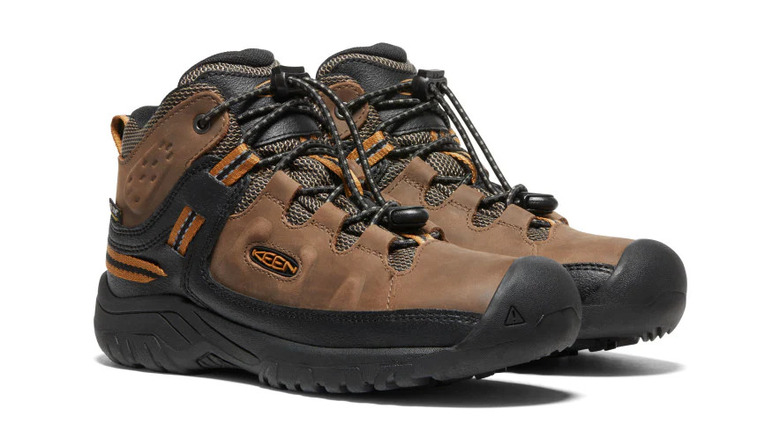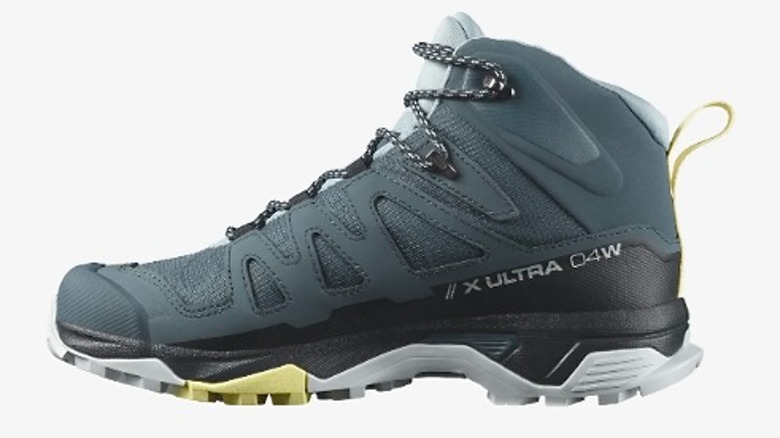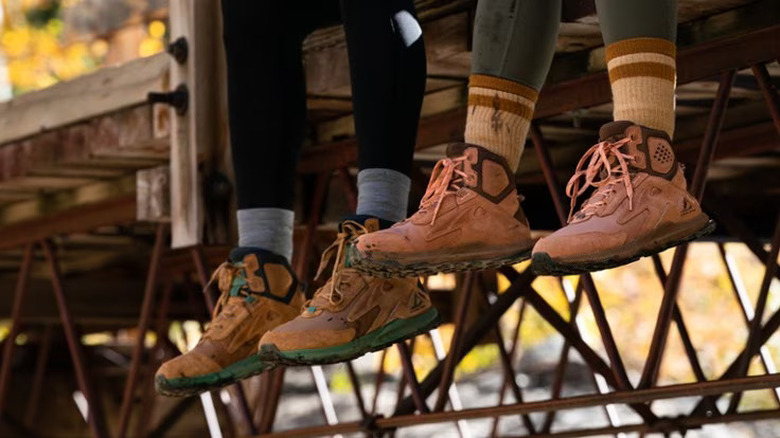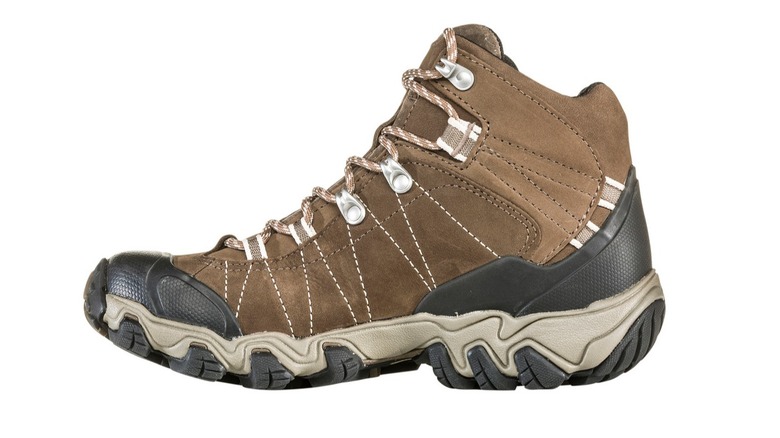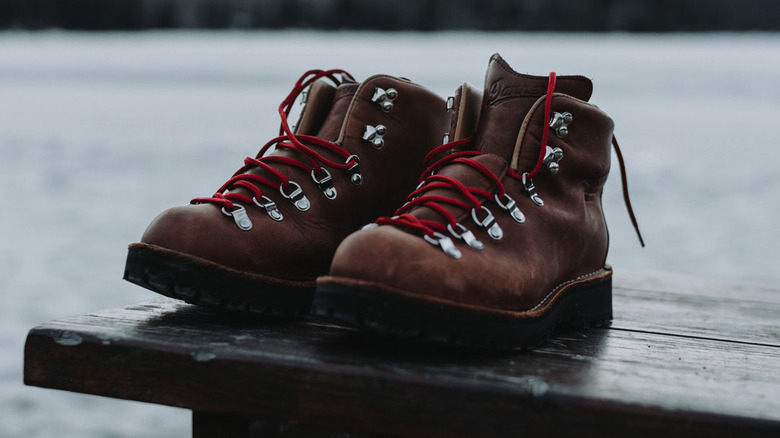The Best Hiking Boots Of 2023, According To Users
We may receive a commission on purchases made from links.
When people picture themselves off on a refreshing adventure, they likely imagine far-off places with exotic landscapes and landmarks that they've only seen on their TV screens. But an elaborate trip that is unkind to your wallet isn't nearly the only way to have a worthwhile and enjoyable time out of the house and away from virtually exploring the world. Whether climbing the Andes or traversing a scenic national park trail, a good pair of hiking boots sets you up for a safe and enjoyable outdoor adventure.
Finding a great pair of boots to trek through the great outdoors is sadly easier said than done, and you'll want to get this shopping decision right. Hiking can be wonderful for your physical and mental health, but your feet and ankles sure do take a beating if you aren't well-equipped. The more comfortable you are in your shoes, the more benefits you reap from your time on the trails. It may sound like you have your work cut out for you in choosing such an important hiking companion, but we've hand-picked some of the best hiking boots of 2023 for you to easily choose which option best fits your needs.
Behind our picks
With tens of millions of Americans showing an interest in hiking, the market for hiking shoes is expectedly vast. Every shoe in this market claims to grant wearers some kind of advantage when it comes to tackling everything Mother Earth can throw at you, whether it be optimal comfort, weather-proofing, or superior ankle support. While not every brand can be the best, there are some that have stand-out shoes with their own strengths that, in our opinion, earn them that title.
There are various factors that have gone into this decision-making process. The features and effectiveness of each hiking boot compared to the obstacles and terrains potential hikers are looking to overcome is the most important element of where a boot falls on the scale of "best." Our deduction of effectiveness came from both new and longtime customer reviews as well as personal experience with various styles and brands of hiking shoes.
We've not only compared reviews of boots from opposite ends of the cost and landscape spectrums but also similar styled and priced boots. It is important to take stock of the value of a shoe in the environment it was created for — like hiking in extreme conditions, rocky terrains, or long distances — and heavier weight was put on features and reviews that reflect that.
Best overall hiking boot
No shoe can truly have it all, so finding a well-rounded hiking boot involves taking a little piece of everything that makes all our other picks the best in their category. The Merrell Moab 3 Mid Waterproof boots takes the cake here, as it is not only a well-priced option but good for multiple terrains, is waterproof, and stays comfortable from the box to hundreds of miles later. As a bonus, the waterproofing also helps to keep out the cold, making the boot a decent choice for chillier weather.
Most hikers are casual hobbyists, and for the average hiker, this boot checks all the boxes and remains a shoe they can keep for years and repurchase when the trail gods finally come calling the shoes home. One Merrell fan even uses the shoe as their everyday shoe, saying, "I wear them for everything my day has to offer. From day to day to do items or going to the ranch and feeding and working with the animals." While the shoe can clearly be worn casually or as a work boot, their crafted purpose of hiking is in good company with the Moabs. "After years of hiking and backpacking my 'go to' boot," another reviewer says, noting they can hike "10 miles with no problems!"
You can get the Women's and Men's Moab 3 Mid Waterproof from Merrell for $150.
Best affordable hiking boot
We're focusing on affordability here because hiking should be accessible for all. Despite many of Mother Earth's great wonders coming with the attractive price tag of free, outdoor hobbies do not come cheap. While it's worth forking over some cash on a solid boot if you'll be hiking regularly, you do not have to spend a lot of money to begin or continue exploring the outdoors. Columbia is a trusted outdoor brand, and their Newton Ridge Plus II Waterproof hiking boot is priced well under most other comparable boots without sacrificing quality.
Regular sales on top of an already reasonable price make grabbing the Newton Ridges practically a steal, especially when you consider the thousands of positive reviews backing them. Many buyers have made the boots their signature hiking shoe and repurchased after they've worn out the previous pair. The suede boot is lightweight and features an outsole with traction needed for traversing various terrains. It's a solid, comfortable shoe good for casual hiking on various terrains — just watch out for heavily wet conditions. Although the boot is waterproof, it may take a while to dry around the mesh tongue.
You can get the Women's and Men's Columbia Newton Ridge Plus II Waterproof Hiking Boots from Amazon starting at around $70.
Best everyday hiking shoe
Almost no one hikes all day every day, and it's nice to have a shoe that can easily go from city street to rugged outdoors. For the spontaneous hiker, having Ridgemont Outfitter's Monty Hi Hiking Boot on your feet makes it possible to give in to your adventurous spirit when the mood to explore outdoors strikes or when you happen across an off-sidewalk opportunity. And while hiking boots aren't known for their trendy appearance, Ridgemont's functional outdoor shoe was specifically created to fill the gap and give the outdoorsman some style.
It looks like a high-top street shoe and comes in a number of color combinations while also offering more ankle support than your typical high-top sneaker and a much-improved tread. For long, strenuous hikes, you may want to opt for something specifically geared toward hiking. This shoe is built for options, though, and makes for an ideal everyday shoe with benefits. One drawback of the Monty Hi's is that they run small and lack a wide option, which is easily corrected with sizing up (the company recommends ordering "a half size up"). Plus, if you don't get the fit right the first time, Ridgemont offers free exchanges for unworn shoes within 30 days so you can try again.
You can get the Women's and Men's Monty Hi Hiking Boots from Ridgemont Outfitters for $149
Best hiking boots for rock scrambling
Encountering rocky trails isn't uncommon when hiking, but there are some hikers who actively search for hikes that involve climbs. While a special shoe isn't required for most mild scrambles, it is wise to offer yourself a little more protection when you know you'll be taking on frequent or challenging climbs. And if you are regularly climbing over rocks while wearing boots rather than lighter-weight shoes, chances are you need some protection from moisture and the cold. The Scarpa SL Active not only delivers on this but also offers all the protection that a good rock scrambling shoe should.
The rubber rand fully encompasses the boot, shielding the heel, toes, and sides of the feet from rock rubs. Scramblers should wear a tread that encourages a good toe grip as well, which the Scarpa does employ. While your own comfort and capabilities should be taken into account when choosing the weight and shape of your preferred scrambling shoe, this Scarpa boot and its proceeding models have been happily used by many advanced hikers and trail workers for decades and is still a top choice in the industry. "These boots are super bombproof and while I can blow through a pair of lightweight hiking boots in a single season, these will definitely be a multiple year boot," one expert hiker noted on the company's website.
You can get the unisex Scarpa SL Active from Scarpa for $359.
Best protective hiking boot
Maybe you are more injury-prone when it comes to the feet and ankles, and wearing a high-top boot might not be enough to save you in this regard. In fact, according to a 2014 study published in the Journal of Foot and Ankle Research, wearing high-top boots will not totally prevent sprained ankles or injuries. Barefoot shoes could be just the protective solution, and Xero's Xcursion Fusion boots reap all the benefits of this type of shoe with the added features of a hiking shoe. As a barefoot shoe, the Xcursion Fusion may help prevent injury by enabling your body to strengthen the 3 A's: your arches, ankles, and Achilles.
As a hiking boot, the high top keeps ankles from being scraped by rocks and passing brush. This boot is also specifically designed for "just right" protection, with a toe cap and supportive layers underfoot that provide wearers great grip while also allowing that signature barefoot "ground feel." One Reddit user felt this protection even after hiking around 80 miles through the Alps! The drawback? In general, wearing barefoot shoes can be a transition, and some users note that it can take up to around six months to start feeling natural in these niche shoes. That means any future trail-blazing should be set for a few months after engaging in the barefoot lifestyle.
You can grab the Women's and Men's Xcursion Fusion from Xero Shoes starting at around $75.
Best boot for plantar fasciitis
For those who love exploring the outdoors, the idea of their body limiting their adventures is a very real fear. According to a 2022 review published in the Journal of Ultrasound, one in 10 people will have plantar fasciitis in their life, along with the chronic heel pain the condition brings with it. Foot pain will deter even the most avid hiker from enjoying their beloved hobby, but the right shoe could help alleviate the discomfort and keep flare-ups at bay. The best option, according to online reviews (and some orthopedic physicians!), is the KEEN Targhee III.
This boot provides a great insole for shock absorption and little to no break-in period for comfort right out of the box. A number of reviews reference their plantar fasciitis diagnosis in relation to the KEEN Targhee III boot, saying that their feet feel great in the shoe. "Highly recommended by my Orthopedic Physician for Plantar Fasciitis issues," one reviewer wrote. "I have plantars Fasciitis ... I love the Targhee Mid! I felt comfortable hiking in these all day long (10 hours plus)," another one commented. The boot is becoming a go-to for those with the condition.
You can get the Women's and Men's Targhee III Waterproof Mid from KEEN Footwear starting at $125.
Best hiking boot for kids
Your outdoor expeditions don't need to end when kids enter the picture — they can actually get more exciting with the whole family in tow. While a child's lightweight and resilient nature makes them less likely to need a specialized shoe, investing in a pair for long or frequent outings may be a good idea. KEEN's Targhee Waterproof Boot for kids delivers the most important things to consider when searching for a child's hiking boot: wearability and protection. You may be patient enough to break in a pair of stiff shoes, but kids would likely rather walk a trail barefoot than wear something uncomfortable and restricting.
The kids' Targhee leads the pack by having a customizable fit with bungee laces, which quickly form themselves to the foot of the young wearer. As far as protection goes, the boots' waterproof feature and reinforced rubber will keep your child's feet safe from the elements and terrain. "This hiking boot was perfect for my daughter," wrote one reviewer, who gave the boot five stars. "She wore these for hours and never complained once about her feet hurting. She loved them and said they were very comfortable." Though sturdy, the top of the shoe has some breathing room to help keep feet dry and comfortable — less shoe sweat means less kid stink, which is a win for everyone.
You can get the unisex Targhee Waterproof Boot for kids from KEEN Footwear for $75.
Best backpacking boot
Much like runners who set marathon goals, a lot of hikers aim to check long-distance hikes off their backpacking bucket list. Though some hikers prefer to wear a trail runner on long-haul hikes, a lightweight hiking boot can offer the benefits of a trail runner while also adding a little extra support. The Salomon X Ultra 4 Mid Gore-Tex is the perfect example of this hybrid shoe, having the flexibility of a sneaker or trail runner and the stability of a hiking boot. The result is a boot with increased agility that won't wear out halfway through your trek.
Despite being marketed as a shoe best for single-day hikes, reviewers have put the X Ultra 4's to the test, with one outdoorsman commenting on Salomon's website that he "hiked or ran up and down the mountains for 92 miles ... These boots performed flawlessly on steep, rocky terrain." Of course, there are other factors that may come into play when choosing a backpacking boot, like climate and how heavy your pack is, but backpackers have happily trusted Salomon to get them through hundreds of miles of trail.
You can get the Women's and Men's X Ultra 4 Mid Gore-Tex from Salomon for $175.
Best boot for desert hiking
While you may associate hiking with lush mountain trails, there's a whole world of terrain out there to explore, about ⅓ of which is considered desert. Because deserts can vary a great deal, you'll want to research the landscape in which you'll be hiking. A light to midweight boot, like the Altra Lone Peak Hiker 2, is ideal for various desert climates and terrains. Traversing desert rock scrambles like those found in the West Coast's national parks is made easy in these boots, and one buyer — who gave the boot five stars — recalls hiking "6 miles in the Mojave, washes, hills, desert" comfortably in the Altra Lone Peak Hiker 2 Hiking Boots.
It's not just arid deserts that the Altras thrive in, as another reviewer on Switchback Travel spent three days traversing the cold desert of Patagonia while wearing the boots. The light feel and breathable material of the Lone Peak Hikers make for an ultra-comfortable wearing experience, but they did note they didn't perform that well on "tricky terrain." They are not waterproof, which avoids the heat retention problem caused by the GTX feature most other picks have. One drawback described by buyers is that they can be harder to get on than other boots — once they're on your foot properly, though, it's smooth hiking!
You can get the Women's or Men's Altra Lone Peak Hiker 2 Hiking Boots from REI for $150.
Best for cold climates
One of the great things about hiking in the cold is the lack of sweat-drenched clothes, but chilly environments do have their drawbacks. Icy or snowy conditions could make traversing a trail or backcountry difficult, which is where the Oboz Bridger Mid Waterproof hiking boot comes in. The boot is made of nubuck leather and has thick soles, which protect from the cold and hazardous trails. No rocks or ice will be tearing into your boots or feet while you're wearing these. The tread on the Oboz is made for taking on uneven and rugged terrains, perfect for ice-covered trails.
Unlike hiking in the desert, you will need waterproof capability in the shoes you choose to go out in any icy or wet climate. Not only will the feature keep you dry, but it really does make the inside of a boot warmer by trapping your body heat within. The Oboz boot delivers here as well with the B-DRY technology, making the entire shoe waterproof. This waterproofing, combined with the company's unique insole, promises a dry and blister-free hike from start to finish. "These boots stood up to everything the rugged north could throw at them," one verified reviewer commented on Oboz's website. "Boulders, rocks, fallen trees, mud bogs, rainy days, you name it and I felt totally comfortable, safe and dry throughout."
You can get the Women's or Men's Bridger Mid Waterproof hiking boots from Oboz Footwear for $200.
Best long-lasting boot
There's arguably nothing better than a pair of well-worn boots. Wearing the same pair of boots regularly can create a unique kind of bond, but only if the shoes can last long enough for the wearer to form this connection. There's actually a "buy it for life" subgroup of hikers and consumers who aim to live a sustainable life with long-lasting products, and Danner boots have found a home amongst them. The hardy brand has been known to last over a decade — which is pretty amazing for a work or hiking boot — and their Mountain Light boot is ideal for the outdoors.
A number of their leather boots, including the Mountain Light, can be recrafted by Danner to look as good as new once worn down. This makes the boots' potential lifespan practically unending — and who doesn't want an immortal boot? A boot doesn't have to be long-lasting if it isn't reliable, though, so where does the Danner Mountain Light fall on comfort and dependability? Pretty darn good! Handcrafted and American-made, the versatile hiking boots employ a Vibram Kletterlift outsole for peak performance and shock absorption. You could wear these every day for years and still feel the quality in your hikes.
You can get the Women's and Men's Mountain Light from Danner for $440.
